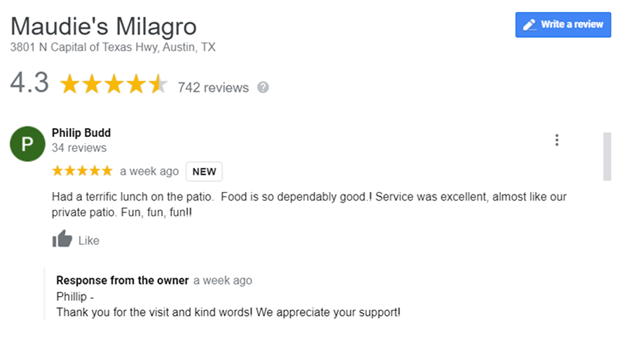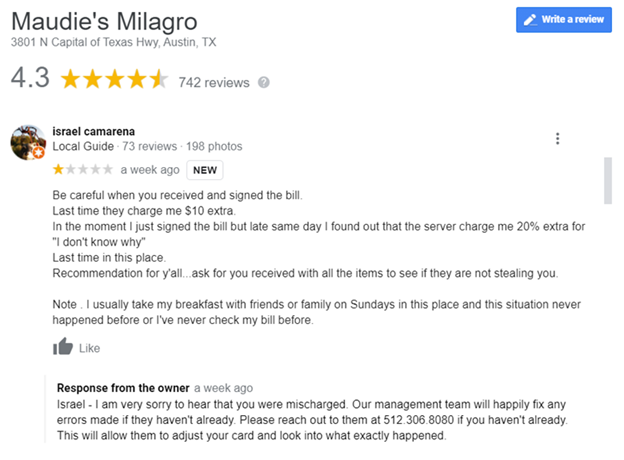Not many people check the phone book anymore before contacting a restaurant, store or service. Instead, they are reaching for the little computer in their pocket and taking their search to the internet, which means they will see the reviews that show up with your business.
According to BrightLocal, 87% of consumers read online reviews for local businesses before making a purchase. Additionally, nearly 80% of consumers trust online reviews as much as they trust personal recommendations. If that's the case, don't you want to make sure you are getting the best reviews to drive in more business?
Editor's note: Looking for the right online reputation management company for your business? Fill out the below questionnaire to have our vendor partners contact you about your needs.
How to get positive reviews
Getting customers to leave positive reviews may seem difficult, especially if you just started your business, but there are several steps you can take to get there.
1. Ask for reviews.
It may sound simple, but asking customers to leave a review can be an effective place to start, especially for small business owners. This can be done during the sales process, in person or online.
Online reviews
When a customer makes an online purchase, you can encourage them to leave a quick rating or review with a website pop-up. Pop-ups should be brief and limited to one or two questions. You can also use email surveys and social media to ask for reviews. These surveys should also be quick and easy to complete.
Plenty of tools now allow you to send out review invitations by text or email to customers. Grade.us, Trustpilot and ReviewTrackers are a few that offer this service. Besides requesting reviews for you, some services track all of your reviews across multiple platforms in one convenient place. If you are looking for a review management platform that can help you acquire and manage your online reviews, check out our BirdEye review and our Podium review.
In-person reviews
If you have a customer who appreciates the service you provided and keeps giving you vocal compliments, ask them to leave you a review on Google, Yelp or your Facebook page. They'll say, "Of course!" Many will likely forget by the time they get back in their car, but some of them will do it. Simply asking is a good place to start, but people often need reminders.
2. Be on review platforms.
It can be difficult for customers to leave you reviews if your business doesn't have an online presence. For this reason, it's essential to have active accounts on review platforms so customers have a place to review you. Some of the most common review platforms are Yelp, Facebook, Google and the Better Business Bureau.
3. Respond to all reviews – even the negative ones.
Once you have active review platform accounts and the reviews start rolling in, it is important that you respond to them. When responding to customer reviews, be sure to address both positive and negative reviews. It may be tempting to ignore negative reviews and pretend they don't exist, but this is a recipe for disaster. Leaving a negative review unaddressed can project to customers that you don't value their opinions or the customer experience. On the other hand, tactfully addressing negative reviews can demonstrate your commitment to your customers, defuse situations before they escalate and sometimes even win customers back.

4. Share positive reviews on your website and social media.
When you garner positive reviews, don't be afraid to show them off. You can share positive reviews on your website and social media accounts to increase their visibility. This not only shows that you have a positive reputation, but it can also remind other happy customers to follow suit and write about their great experiences.
5. Review your customers positively.
Some have success in gaining customer reviews by being proactive and reviewing their customers first. While this may not be an option for some businesses, if you use a platform that allows it (such as Airbnb or Uber), you can leave positive customer reviews in hopes that the customer will reciprocate.
6. Offer incentives.
Businesses can benefit from incentivizing reviews, but not in the way you might be thinking. You can create an employee review program that rewards employees for receiving positive customer reviews. This incentivizes your employees to ask customers for reviews, and it incentivizes customers to leave reviews to help their favorite employees earn rewards.
Keep in mind that you shouldn't incentivize customers for leaving reviews (e.g., giving customer discounts in exchange for reviews). It is against Google's (and most other platforms') guidelines to offer customer rewards for leaving a review. This skews the reviews you get and leads to distrust, not to mention that your reviews could be deleted if the online platform finds out.
7. Train your customer service reps.
The best way to bring in positive reviews is to offer great customer service. Make sure everyone has been trained on how to treat customers right, because if they don't, you can be sure that someone will post about it.
The only problem with happy customers is that they don't generally think to leave a review for good service. People are typically more vocal when they are upset. It's good to give those happy customers a little push in the right direction.
8. Host events to meet customers.
Putting a face to your name can be a valuable way to connect with your audience, especially for small businesses that depend on their local community for success. Think of events or activities you can host to engage and entertain customers.
Hosting events can help build your brand and make customers feel connected to you. When you build that personal connection, be sure to let them know how much a positive review could help your business.

9. Use social media.
Social media is a valuable tool when it comes to perpetuating your business reputation, especially social platforms like Facebook, TikTok, LinkedIn, Instagram and Twitter. To realize that value, you can't simply have social media accounts; you need to be active. Your customers are already on social media, sharing their opinions and experiences with friends and family, and that is something you can capitalize on. When you engage with your customers on social platforms, you can also encourage them to review your product or service within these platforms.
10. Do your job right.
When you offer a great product or service, it can sometimes speak for itself. Focus on honing your craft to create the best product or service you can. When customers notice that you are providing a valuable, high-quality product or service, they are more likely to leave positive reviews.
The importance of customer reviews
Customer reviews have become a standard part of the consumer experience, from start to finish. Customers not only rely on reviews to learn more about your products and services, but they also use them as a way to interact with your business and inform other prospective buyers about their experience.
In the 2020 Local Consumer Review Survey by BrightLocal, 72% of U.S. consumers said they'd written a review for a local business. What those ratings and reviews say matter: More than 50% said they won't even consider using a business with fewer than four stars.
Your customers aren't the only ones who should be leaving comments in your business review section. Replying to customer reviews can be a good way to engage with your audience and address unsatisfied customers. In fact, 20% of consumers who write reviews expect businesses to respond within one day, according to the BrightLocal survey. When you understand the importance of customer reviews, you can use them to your advantage.
Examples of positive and negative customer reviews
To give you an idea of what positive and negative customer reviews look like, check out these examples:
Positive customer review
In this lighthearted review, the customer lists a few reasons why they rated this restaurant five stars. Although the review was short and simple, the restaurant owner still took the time to respond, thanking them for their support. This type of response shows that they value their customers.
Negative customer review
In this negative review, the customer shares a detailed explanation as to why they rated this restaurant one star. The customer also said that "this situation has never happened before," which might mean that they have had multiple positive experiences with this establishment and chose to leave a review only because they had a negative experience. This is very common with reviews, and it is important for businesses to address negative reviews.
The restaurant owner promptly responded to the review to offer their apologies. They also included follow-up details to resolve the customer's problem of being overcharged.
Which online review platforms should you use?
The top dog of the online review world is Google. Most people start their search on Google and browse through the businesses and reviews that they find.
To make sure you show up on Google, you need to create a Google My Business listing (if you don't already have one). Go to business.google.com to get started. Be sure to optimize your listing to show up well. Getting reviews on your Google listing will increase your business's visibility and help convert leads into customers.
Other platforms that are always good to show up on, if only for review purposes, are Facebook, Bing and Yelp. You may even want to look into industry-specific platforms, like Healthgrades for doctors or Houzz for home builders.
You'll want most of your reviews to go to your Google listing, but make sure that you get a few reviews on each of these other platforms as well.
How many reviews do you need?
Looking at your competitors' listings is a good place to start to determine how many reviews you should aim for, but there really isn't a set number. The most important thing is to bring in a steady stream of reviews. Start by trying to get at least one or two a month, and then maybe one or two a week if you have a lot of customers coming and going each day.

A word of caution, though: Don't get too many reviews at once.
This may sound counterintuitive, but getting too many reviews at once (especially if all of them come from your IP address or location) can send up red flags. It looks unnatural, and it could result in losing your hard-earned reviews. A review management service can be a good way to deal with this issue; many allow you to automate the review invitation to send a certain number out each day. This spreads out the reviews to make it look more natural, because it is!
Do your research, find out which platforms are relevant to your business, and even if you're already there, follow the above tips to keep a steady stream of reviews coming in so they are always fresh for potential customers.
Kaili Killpack contributed to the writing and research in this article.


